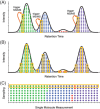Data acquisition approaches for single cell proteomics
- PMID: 39088833
- PMCID: PMC11735665
- DOI: 10.1002/pmic.202400022
Data acquisition approaches for single cell proteomics
Abstract
Single-cell proteomics (SCP) aims to characterize the proteome of individual cells, providing insights into complex biological systems. It reveals subtle differences in distinct cellular populations that bulk proteome analysis may overlook, which is essential for understanding disease mechanisms and developing targeted therapies. Mass spectrometry (MS) methods in SCP allow the identification and quantification of thousands of proteins from individual cells. Two major challenges in SCP are the limited material in single-cell samples necessitating highly sensitive analytical techniques and the efficient processing of samples, as each biological sample requires thousands of single cell measurements. This review discusses MS advancements to mitigate these challenges using data-dependent acquisition (DDA) and data-independent acquisition (DIA). Additionally, we examine the use of short liquid chromatography gradients and sample multiplexing methods that increase the sample throughput and scalability of SCP experiments. We believe these methods will pave the way for improving our understanding of cellular heterogeneity and its implications for systems biology.
Keywords: data dependent acquisition; data independent acquisition; mass spectrometry; multiplex; proteomics; single cell.
© 2024 The Author(s). PROTEOMICS published by Wiley‐VCH GmbH.
Conflict of interest statement
Brian C. Searle is a founder and shareholder in Proteome Software, which operates in the field of proteomics.
Figures



Similar articles
-
A rapid and sensitive single-cell proteomic method based on fast liquid-chromatography separation, retention time prediction and MS1-only acquisition.Anal Chim Acta. 2023 Apr 22;1251:341038. doi: 10.1016/j.aca.2023.341038. Epub 2023 Mar 2. Anal Chim Acta. 2023. PMID: 36925302
-
Data-Independent Acquisition Shortens the Analytical Window of Single-Cell Proteomics to Fifteen Minutes in Capillary Electrophoresis Mass Spectrometry.J Proteome Res. 2025 Apr 4;24(4):1549-1559. doi: 10.1021/acs.jproteome.4c00491. Epub 2024 Sep 26. J Proteome Res. 2025. PMID: 39325989 Free PMC article.
-
Mass Spectrometry-based Solutions for Single-cell Proteomics.Genomics Proteomics Bioinformatics. 2025 May 10;23(1):qzaf012. doi: 10.1093/gpbjnl/qzaf012. Genomics Proteomics Bioinformatics. 2025. PMID: 39985441 Free PMC article. Review.
-
Cell Storage Conditions Impact Single-Cell Proteomic Landscapes.J Proteome Res. 2025 Apr 4;24(4):1586-1595. doi: 10.1021/acs.jproteome.4c00632. Epub 2025 Jan 24. J Proteome Res. 2025. PMID: 39856491 Free PMC article.
-
Are We There Yet? Assessing the Readiness of Single-Cell Proteomics to Answer Biological Hypotheses.J Proteome Res. 2025 Apr 4;24(4):1482-1492. doi: 10.1021/acs.jproteome.4c00091. Epub 2024 Jul 9. J Proteome Res. 2025. PMID: 38981598 Free PMC article. Review.
Cited by
-
Single-Cell Proteomics Using Mass Spectrometry.ArXiv [Preprint]. 2025 Mar 29:arXiv:2502.11982v2. ArXiv. 2025. PMID: 40034135 Free PMC article. Preprint.
-
Overcoming Preservation Challenges to Enable Single-Cell Proteomics of Fixed Cells and Tissue Samples with Retained Proteome Integrity.J Proteome Res. 2025 Jul 4;24(7):3666-3682. doi: 10.1021/acs.jproteome.5c00268. Epub 2025 Jun 19. J Proteome Res. 2025. PMID: 40534510
References
-
- Regev, A. , Teichmann, S. A. , Lander, E. S. , Amit, I. , Benoist, C. , Birney, E. , Bodenmiller, B. , Campbell, P. , Carninci, P. , Clatworthy, M. , Clevers, H. , Deplancke, B. , Dunham, I. , Eberwine, J. , Eils, R. , Enard, W. , Farmer, A. , Fugger, L. , Göttgens, B. , … The Human Cell Atlas . (2017). The human cell atlas. eLife, 6. 10.7554/eLife.27041 - DOI - PMC - PubMed
-
- Shlush, L. I. , Mitchell, A. , Heisler, L. , Abelson, S. , Ng, S. W. K. , Trotman‐Grant, A. , Medeiros, J. J. F. , Rao‐Bhatia, A. , Jaciw‐Zurakowsky, I. , Marke, R. , Mcleod, J. L. , Doedens, M. , Bader, G. , Voisin, V. , Xu, C. , Mcpherson, J. D. , Hudson, T. J. , Wang, J. C. Y. , Minden, M. D. , … Dick, J. E. (2017). Tracing the origins of relapse in acute myeloid leukaemia to stem cells. Nature, 547(7661), 104–108. - PubMed
-
- Nam, A. S. , Kim, K. T. , Chaligne, R. , Izzo, F. , Ang, C. , Taylor, J. , Myers, R. M. , Abu‐Zeinah, G. , Brand, R. , Omans, N. D. , Alonso, A. , Sheridan, C. , Mariani, M. , Dai, X. , Harrington, E. , Pastore, A. , Cubillos‐Ruiz, J. R. , Tam, W. , Hoffman, R. , … Landau, D. A. (2019). Somatic mutations and cell identity linked by Genotyping of Transcriptomes. Nature, 571(7765), 355–360. - PMC - PubMed
-
- Kreso, A. , & Dick, J. E. (2014). Evolution of the cancer stem cell model. Cell Stem Cell, 14(3), 275–291. - PubMed
-
- Ramsköld, D. , Luo, S. , Wang, Y.‐C. , Li, R. , Deng, Q. , Faridani, O. R. , Daniels, G. A. , Khrebtukova, I. , Loring, J. F. , Laurent, L. C. , Schroth, G. P. , & Sandberg, R. (2012). Full‐length mRNA‐Seq from single‐cell levels of RNA and individual circulating tumor cells. Nature Biotechnology, 30(8), 777–782. - PMC - PubMed
Publication types
MeSH terms
Substances
Grants and funding
LinkOut - more resources
Full Text Sources

